Kanchipuram was once the illustrious capital of the mighty Pallavas. Even today, the city has retained its legacy and is considered one of the most important cities in Tamil Nadu.

Table of Contents
History of Kanchipuram:
The history of Kanchipuram is entwined with that of the Pallavas. Founded by Simhavishnu, the Pallavas ruled the southern parts of present-day Andhra Pradesh and northern portions of Tamil Nadu, an area collectively called Tondaimandalam. Gradually, as the Pallava authority spread its wings under formidable kings such as Mahendravarmana I, Narasimhavarmana I, and Narasimhavarmana II, they transferred their seat of power to the Tamil country and established their capital at Kanchipuram.

When the Pallavas converted Kanchipuram into their capital, it was already a major city in India. It featured frequently in South Indian epics and poetry. The Allahabad Pillar Inscription of Asoka contains an inscription from Gupta Emperor Samudragupta in which he claims to have conquered Kanchipuram’s early Pallava king, Vishnugopavarman.

The word Kanchipuram is a combination of two words – ‘kanchi’ means worship of Brahma, and ‘puram’ means residential place. Located on the banks of Vegavathi and Palar rivers, Kanchipuram is one of the ‘Sapta Puri’ or seven sacred places in Vaishnavism, which ensures liberation of the soul. Of the 108 ‘Divya Desam’ or holy places of Vishnu, 15 are located here. Also, Kanchipuram is one of the 51 Shakti Peethas where the navel of Goddess Sati had fallen.

Traditionally, Kanchipuram is divided into four segments – Siva Kanchi, Vishnu Kanchi, Jina Kanchi, and Buddha Kanchi. It is also known as the ‘city of thousand temples’ due to the presence of countless temples here.
Important Temples of Kanchipuram:
As already mentioned, there is no dearth of temples in Kanchipuram. Left and right, you will stumble across nth temples in this bustling city. Here, we have listed four of the most important and sacred temples of Kanchipuram:
Ekambaresvara Temple:
The word ‘Ekambaresvara’ literally translates to the ‘Lord of a Mango Tree’. The legend of Ekambaresvara is recounted in the 12th-century text, Priya Puranam. It is said that Uma had worshipped Siva here in the form of a linga made of sand. Siva was pleased with Uma’s devotion and subsequently manifested himself before her. Finally, the divine couple married beneath a mango tree. A shrine for the tree, believed to be 3500 years old, marked the site of this heavenly event.

The Ekambaresvara Temple is one of the most important temples not only in Kanchipuram but also in Tamil Nadu. The Siva linga here is part of the cluster of ‘Panchabhuta Lingas’. Panchabhuta Lingas are 5 in number, and they manifest the five elements (air, water, fire, earth, ether). The Ekambaresvara linga is ‘Bhumi Linga’ and represents the earth. As per traditional belief, the temple’s main linga is the very one which Uma built from sand. As such, the priests do not perform the ’abhisheka’ on the linga, lest it washes away.
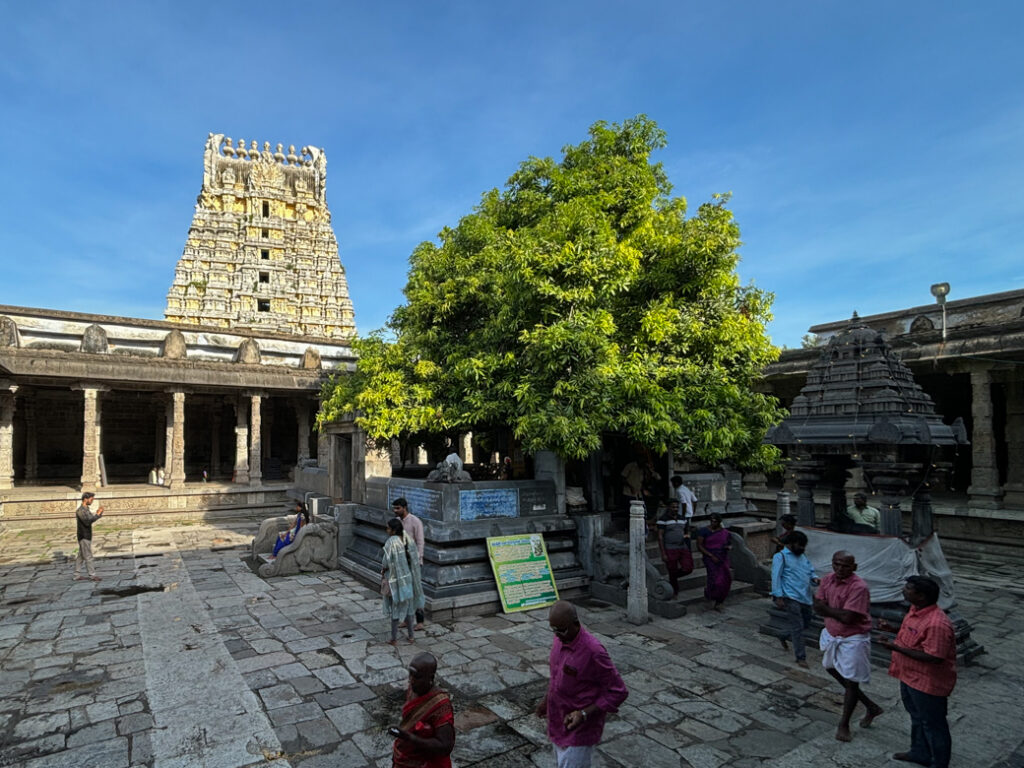
The Ekambaresvara Temple is also the largest temple in Kanchipuram, the central shrine is encircled by 5 ‘prakara’ enclosures. Its soaring 59 m. Gopura is one of the tallest in South India.

Initially, the temple was very likely a simple shrine built of brick. Although nothing remains of the original shrine, granite pillars dating back to the time of Pallava king Mahendravarmana I were discovered in a ruined mandapa near the present-day 1000-pillared hall. Evidently, the Ekambaresvara Temple was not built at a unified moment. Rather it was constructed, expanded, and rebuilt over a long period of time.

Like other Pallava temples, granite was used for the base to support the whole structure while sandstone was employed for the rest of the portion.

Architecturally, it is ‘brahmachhanda’ or square in plan. It comprises a main Vimana fronted with Ardha Mandapa and Mukha Mandapa.

Vaikuntha Perumal Temple:
Regarded as one of the 108 ‘Divya Desam’ of Vishnu, it is the second oldest extant temple in Kanchipuram after the Kailasanatha Temple. Vishnu is worshipped here as the ‘Lord of the Vaikuntha’ and his consort Lakshmi as Sri Vaikunthavalli.

Built by Pallava king Nandivarmana II, the Vaikuntha Perumal is an early specimen of the Dravida style of temple architecture. Its plan is a square cluster Vimana with adjoining Ardha Mandapa. The architectural prototype of the Vimana can be found in the Dharmaraja Ratha of Mahabalipuram. The sanctum is divided into three sanctuaries which house Vishnu in three distinct postures – seated on the ground floor (available to devotees for ‘darsana’), lying on the first floor (visible to devotees only on Ekadashi), and standing on the second floor (inaccessible to devotees).

The cloistered mandapa encircling the main shrine is perhaps the most interesting section of this temple. The cycle of narrative reliefs on the cloister walls provides important information about Pallava history. The temple’s royal relief carvings are akin to royal ‘prasasti’ or eulogies. Narrated in two horizontal registers, the sequence begins on the western wall and runs clockwise around the monument. The narrative proceeds along the upper and then lower register of the walls on each side of the temple individually. They primarily depict coronation scenes along with battles and processions.


The entire north wall depicts the courtly world of Nandivarman I. Then follows the coronation of all kings from Simhavishnu to Paramesvaravarman II compressed together on the last wall. The south wall and half of the west wall depict the biography of Nandivarman II, the chief patron of this temple.

Kamakshi Amman Temple:
The Kamakshi Amman Temple is certainly the soul of Kanchipuram. It is dedicated to Kamakshi (literally means ‘One with the Loving Eyes), who is considered one of the 10 Mahavidyas as well as one of the principal manifestations of the Adi Shakti. It is also one of 51 Shakti Peethas. It is believed that Sati’s navel had fallen here.

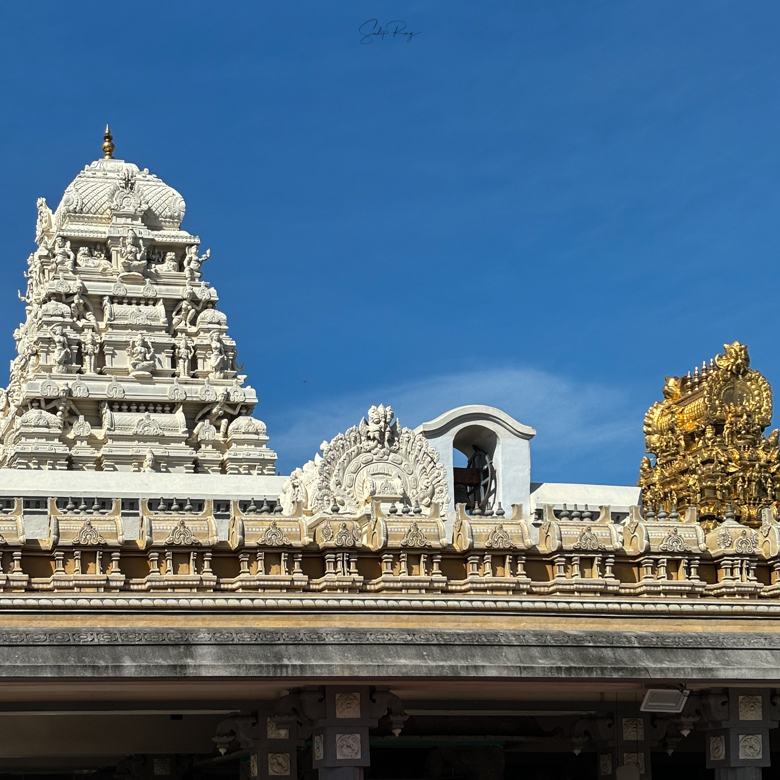
Inside the Garbha Griha, there is an idol of Kamakshi in a seated posture flanked by the Trinity of Brahma, Vishnu, and Mahesvara. Around the sanctum, there are a few minor shrines dedicated to Bangaru Kamakshi, Adi Sankara, and Sarasvati.

Curiously, the Kamakshi Amman Temple also contains one of the 108 ‘Divya Desham’ of Vishnu. It is known as Tirukalavanur and Vishnu is worshipped here in his Varaha avatar. The original temple is, however, in ruins. The deity is now placed inside the Kamakshi Temple as it is believed that Vishnu is Kamakshi’s brother.
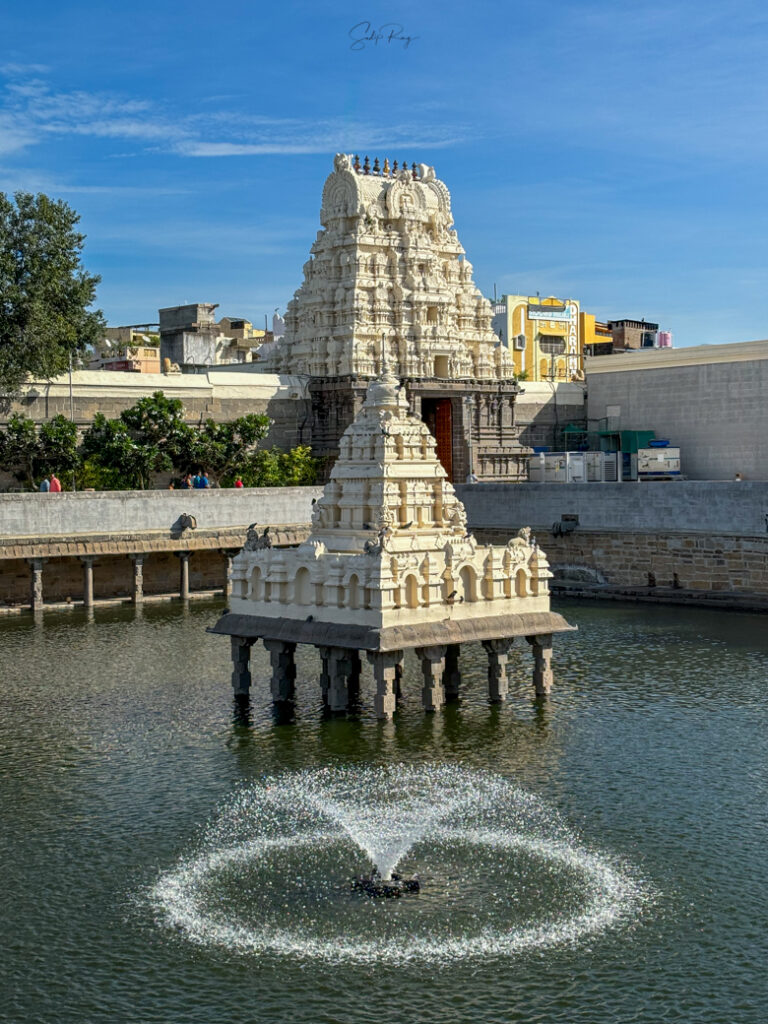
Kailasanatha Temple:
It is the oldest structure in Kanchipuram. It was the first of its kind and eventually became a trendsetter for other similar temples in southern India. Not only is it the most fully realised Pallava monument, but also stood among the largest Hindu temples in India at the time of its construction.

Dedicated to Siva, it was commissioned by Narasimhavarmana II Rajasimha. His queen consort Rangapataka also actively collaborated in this grand venture. Construction was set in 685 CE and completed in 705 CE. The temple is also known as Rajasimhevara after its author.

The east-facing temple is comprised of Garbha Griha or sanctum sanctorum, Antarala or inner enclosure, Mandapa, Prakara, and a small Gopura. The temple complex is encircled by 58 small shrines called ‘Devakulika’. Each houses an image in its sacred centre such as Soma Skanda, Siva as Gangadhara, and so on.
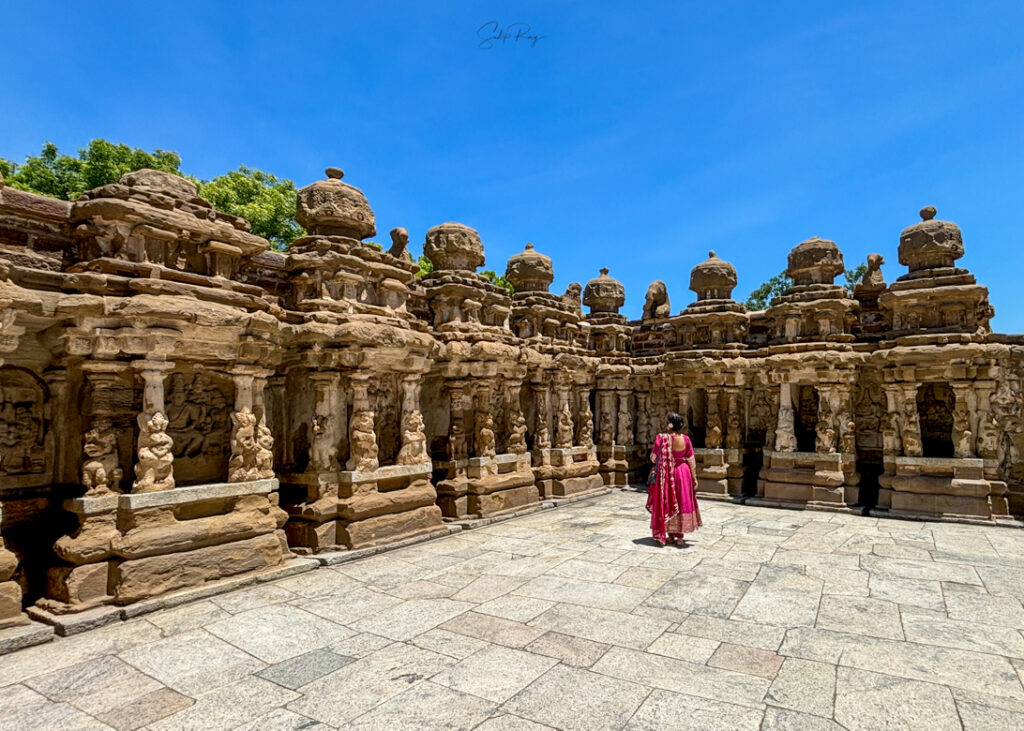
The sculptures on the outer walls of the Kailasanatha Temple are monumental in scale and represent the most refined artistic excellence in the corpus of Pallava art. In the south-facing wall, noted carvings are Uma – Mahesvara with Varaha raising the Linga, Siva as Dakshina Murti, Siva as Lingodbhava; on the west, sculptures of Siva as Sandhya Tandavamuti and Urdhava Tandavamurti are found; the north wall depicts Siva as Tripurantaka, Durga as Mahisasuramardini, Bhikshtana, and Siva as Samahara Tandava.


The temple complex has another shrine right at the entrance. It was built by Rajasimha’s son Mahendravarmana, who sadly pre-deceased his illustrious father. This smaller shrine is called Mahendravarmesvara.

Important FAQs:
Where is Kanchipuram located?
Kanchipuram is located 75 km away from Tamil Nadu’s capital, Chennai.
How can I reach Kanchipuram?
By train: As many as 16 trains ply between Chennai and Kanchipuram. You can check their schedule here.
By bus: Lots of buses from Mahindra City bus stop in Chennai travel to Kanchipuram on a daily basis.
By air: The nearest airport is Chennai. From Chennai, you can easily reach Kanchipuram by train, bus, or by hiring a cab at your convenience.

Where can I stay in Kanchipuram?
Being a popular pilgrimage centre, Kanchipuram offers various options for accommodation. We stayed at the centrally located Shree Shakti Residency. Some other top-rated hotels are TTDC Hotel Tamilnadu – Kancheepuram, Regency Kanchipuram, and Nitheesh Residency.

Where to eat in Kanchipuram?
Popular chain restaurants of Tamil Nadu such as Nithya Amritham and Saravana Bhavan have branches in Kanchipuram. Also, try the iconic Kovil Idli of Kanchipuram, offered as ‘Prasada’ at Varadaraja Perumal and Vaikuntha Perumal Temples.
What is the best time to visit Kanchipuram?
October to March is ideal for visiting Kanchipuram.
Do the temples in Kanchipuram have any opening and closing times?
All the temples in Kanchipuram observe strict time frames. Except for Kailasanatha Temple, the temples remain open from 6 AM to 12 PM, and again from 4 PM to 8 PM. The Kailasanatha Temple opens at 9 AM.
Is any entrance fee required for the temples?
No entrance fee is required to enter these temples.
Is there any dress code for entering the temples in Kanchipuram?
There is no strict dress code. But since all temples in Kanchipuram are active, it is wise to put on a modest dress that covers your hands and legs.

What are the other temples in Kanchipuram?
Apart from these four temples, you can also visit Varadaraja Perumal Temple, Shri Chitragupta Swamy Temple, and Shri Ashtabhujakara Perumal Temple,
Where can I buy Kanchipuram Silk?
Apart from temples, Kanchipuram is renowned for its silk sarees. For authentic Kanchipuram Silk, visit Nalli Sarees, Sri Sarvalakshmi Silks, and PS Silk Saree Shop.

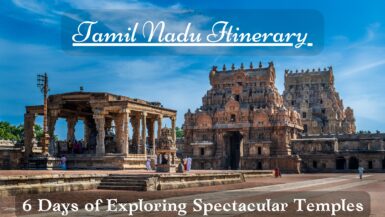


A splendid, vivid and obviously lively description that really inspires us to visit once in this place…. Thank you very much for this blog and please please keep it up for us who are not always physically able to witness this wonderful creation of India…
Glad you liked this article.